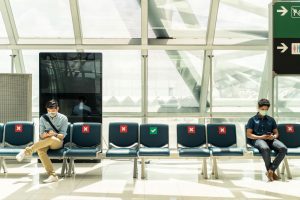
Ayesha Ahmad, USA
The first COVID-19 deaths in one of our affected nursing homes stand out vividly. Mr. R had heart failure and anemia but still loved to chat and smoke on the patio. He was looking forward to discharge to a retirement high-rise, but instead battled COVID-19 at a local hospital ICU before passing away. Mrs. M, a delightful Pennsylvania Dutch woman who had been on dialysis for 15 years, died after just one day of mild symptoms. And Mr. P, who had defied critically low platelets and was actually doing well in the second week after contracting COVID-19, ultimately succumbed to it; he was found ashen and without a pulse.
In March 2020, the COVID-19 pandemic swept through the Mid-Atlantic States months before the rest of the United States and we were caught completely off guard. The hospitals began to swell up by late March and early April. At that time the entire focus was on acute hospital care and ERs, and while hospitals, especially ERs and ICUs did suffer, our nursing homes (called care homes in Europe) were truly devastated. While the ‘epicenters’ of this new disease burned, the yet unaffected states and regions looked on, some with sympathy and fear of what was coming and some with skepticism and a false sense of bravado.
There are about 15,600 nursing homes in the USA that hold about 2.4 million residents. In my state of Pennsylvania, there are approximately 700 nursing homes with around 88,000 beds. A large percentage of residents in the home are long term residents who reside there as they are unable to care for themselves. The long-term residents are generally older patients, often females with dementia or chronic illnesses that affect mobility and function, and often with poor social supports. It is naïve to suggest they be pulled out of nursing homes as they no longer have a home or a committed family member to take care of them.
There has been a culture shift in recent times as nursing homes have rebranded themselves into rehabilitation facilities. A sizeable number of patients come to these homes temporarily in a designated unit to get physical, occupational, and speech therapy or wound care after an acute illness with the intention of returning to their homes soon. This stems from a trend in US hospitals to discharge patients ‘sicker and quicker.’
We knew this vulnerable group of both short and long-term residents would be impacted, and the pandemic proved our worst fears to be true. The nursing home physicians who had initially volunteered to handle COVID patients in the hospital ICUs and medical floors were soon caught battling outbreaks in their own facilities.
Based on CDC guidelines, all visitation stopped on March 13th. Masks were made mandatory shortly thereafter and employee screenings for symptoms followed. Guidelines as well as taskforces were also developed. We did not know much about the disease and its varied presentation back then. COVID-19 managed to find its way into many facilities; sometimes the virus came from an asymptomatic nurse or aide, sometimes from a patient who came from the hospital (there was no universal screening prior to transfer in early months) and occasionally from a patient exposed to others during physician visits or dialysis visits. When it did, you could rest assured that for one newly diagnosed case there were likely 10 more lurking. We had instances of an entire hallway of patients testing positive within days of exposure to an asymptomatic aide. The care of patients in nursing homes requires close and prolonged contact; from feeding to incontinence care to bathing and shaving. In the time it took to develop symptoms, often the spread of virus was already out of hand despite PPE.
We saw the pandemic spread across central Pennsylvania nursing homes. Earlier in the pandemic all the focus was on hospital care, testing was limited, and PPE was in shortage. A large 400 bed facility in central Pennsylvania developed cases across all floors sparing only a third of its residents. There was almost a microcosm of the national pandemic in that facility. Despite PPE and education of staff, the virus spread like wildfire and claimed 49 lives in the 2 months that it raged. Staff became infected and many of them called in out of fear. There was such a critical staff shortage that the National Guard had to be called in. They were meant to help for only three days, they ended up staying for more than three weeks. Some patients died in hospital and many in the facility; both unable to say goodbye to their loved ones in person. The nurses and aides for whom these long term patients were like family grieved deeply and managed to work double shifts while battling physical and emotional fatigue; 12 hours of wearing PPE, low morale, and fear for their own and their family’s health. Though some physician teams adopted tele-health many of us felt it was important to see our patients in person and update families and discuss and update goals of care. Even in good times, nursing homes struggle with staffing and resources and the pandemic put many of them in precarious states. The stories were varied and deeply sad. There was the older man with dementia whose daughter revoked DNR orders who was recovering from COVID-19 but died suddenly, likely from a thromboembolic complication (which was just being recognized). The 49-year-old with a traumatic brain injury who had outlived so many complications and had come off hospice finally succumbed to COVID-19. The 84-year-old who beat COVID-19, recovered, but soon after coughed up blood only to die of lung cancer weeks after. The hardest part were the goodbyes, often on video chats though in some cases in person compassionate visits were allowed. By late spring we had lost more than 5000 residents to COVID-19 in the state. 68% of all deaths in Pennsylvania were in nursing homes in the spring wave.

Fast-forward to fall of 2020; at the time of writing, 6751 nursing home residents have died from COVID-19, reflecting about 61% of all Pennsylvania COVID-19 deaths. Almost every home across the state, from the ritzy high end homes for the well to do, to the basic ones that take the “have nots” have been affected. Most nursing homes were not able to open to visitors as one of the criteria for allowing visitors is not a single case of COVID-19 should occur among patients and employees in the preceding 28 days. Patients are pining to see their loved ones; window visits do not work for everyone. Patients have shown symptoms of depression, neuropsychiatric behaviors, and accelerated cognitive decline. Families are sad and helpless. By now the community spread in our rural and urban counties is immense. Some of the homes that saw outbreaks in the spring and early summer months are now battling fall outbreaks. Yes, we know more about the disease and therapeutics but the death rates in nursing homes remain egregiously high.
There have been many lessons learned. Lessons on frequent universal testing of patients and staff, when to stop transmission based precautions, managing staffing, calling local agencies for help, PPE “policing”, education and emotional support of staff and ‘cohorting’ residents who have tested positive in designated zones. Since June, all nursing home residents get swabbed for the virus regularly and in some counties weekly and now biweekly. That itself is a huge undertaking; imagine having a large facility and performing hundreds of swabs bi-weekly in addition to testing all employees, from nurses to aides to laundry and kitchen staff.
All front-line workers deserve a shout out, but to me one of the most important lesson was how much a nursing aide does for a patient in an average day. He or she spends hours with the patients feeding them, providing incontinence care, bathing them, turning them, and providing human touch often at minimum wage with little or no hazard pay. It is those that I really began to appreciate in this crisis.
In Islam and in many Eastern cultures, the care of elders is the responsibility of family units whereas in the West, society is more individualistic. The kind treatment of the elderly, whether they be parents, grandparents or otherwise, is a fundamental and integral teaching. God Almighty states in the Holy Qur’an,
‘Thy Lord has commanded, “Worship none but Him, and show kindness to parents. If one of them, or both of them attain old age with thee, never say unto them any word expressive of disgust not reproach them, but address them with excellent speech. And lower to them the wing of humility out of tenderness.” [1]
The message here is profound; after the worship of God and obedience to Him, humans are tasked with tending to the elderly in a manner of loving and affectionate care without the slightest expression of reproach.
What kept many of us going despite the exhausting and taxing work was our patient’s vulnerability, seeing as they were already without their families, our frail older adults became even more vulnerable without family visits. Hundreds of huddles and meetings later, though we still find ourselves grappling with grief some days to lose a patient to an illness that could have been prevented. This pandemic has exposed many systemic weaknesses in the USA and many other countries. From healthcare disparities to economic inequality to what really is essential for societies and what is not. It has fanned discussions on the opposing forces of individual liberties vs rights of society. It has also made us reflect on the lives lost of older adults. Let us hope that as this pandemic recalibrates so many practices, it will also make societies reflect and improve the care of older adults across all settings.
About the Author: Ayesha S Ahmad, MD, FACP, AGSF is a board certified Internist and Geriatrician serving as faculty at Penn State Health. She is the program director for Geriatrics fellowship and also serves under Penn State’s office of Diversity in various roles. Her areas of interest are end of life, dementia and culturally competent care.
ENDNOTES
[1] The Holy Qur’an 17:24-25




Add Comment